
This paper was written as part of the 2003 Alaska Ocean Sciences Bowl high school competition. The conclusions in this report are solely those of the student authors.
Effects of Cruise Ships on S.E. Alaskan Environment and Economy: Support for the Changing Industrial Standards
Authors

Introduction
Within Southeast Alaskan waters thrives an extensive abundance of aquatic flora and fauna. The fjords, canals, and estuaries of the Panhandle—the coastal communities, specifically Juneau, and the surrounding marine territories—are habitat to a vast ecosystem that has become important to Southeast's society and culture. Also important to society and culture is the utilization of such resources.
The conflict between the cruise ship industry and the preservation of the aquatic habitat has recently reached a breaking point. Environmentalists, citizens, visitors, and now even the government all know that measures must be taken to protect the marine ecosystems, and the solution must not be a threat to the fragile economy. Recently, the City and Borough of Juneau (CBJ) and the state of Alaska have shown a greater interest in the problem, and have chosen a starting point toward the reversal of oceanic degradation: the cruise ship industry.
This report will discuss the merits of the changes made regarding cruise ship regulation—first, it will discuss the history of regulation and the current regulation concerning the matter of cruise ship waste discharge; second, it will explain, in depth, the specifics of cruise ships and the effects they have on environment and economy; and finally, it will offer a comprehensive strategy to reduce environmental impacts of the industry.
Legislation
Historical
Since the discovery of Alaska, it has amazed and impressed millions of people. People of all cultures have made the trek northward to experience the natural wonder that we call home. During the summer, nearly 45,000 passengers travel through Alaskan waters every day. That number continues to grow each year; also continuing to grow is the waste carried on board every ship. Before the Refuse Act of 1899, there were no regulations concerning pollution from ships. This act prohibits "throwing, discharging or depositing any refuse matter of any kind into the waters of the United States." (www.boatsafe.com, 1999) Then in 1948, the Federal Water Pollution Control Act "requires all vessels with propulsion machinery to have a capacity to retain oily mixtures on board." (www.boatsafe.com, 1999) Also required is a means to deliver the oily waste product to a proper facility. The U. S. Coast Guard has set regulations on the discharge of solid waste, which "prohibit dumping of plastic refuse, and garbage mixed with plastic, into any waters." (www.boatsafe.com, 1999) Each of these regulations apply to all vessels operating in the U. S.
Federal Water Pollution Control Act Amendments of 1972 and the revisions of the act, known generally as the Clean Water Act, were originally introduced to give the Environmental Protection Agency (EPA) the power to apply programs to control water pollution targeting pollution by industries. The Act created the basis for discharge regulations in the United States marine waters. It set the standards for the multiple subsequent bills and acts concerning the issue of waste disposal, and caused an increase in interest in the issue of conserving the ocean ecosystems.
In 1999, the City of Juneau passed a head-tax placed on each passenger aboard incoming cruise vessels of five dollars per person. This tax is used to fund recreational facilities and programs throughout the city, and to maintain city property. The tax has remained stable, but the potential for the tax to increase is great, and there has been much discussion of a state-wide tax that would cost the cruise line companies "more like $50 per person—this hasn't yet been passed," (Beth Kerttula, per. comm., 2002). The general attitudes of cruise ship representatives toward the head tax are unfavorable, as they see it as an unnecessary risk on Alaska's part. They believe that "'with the national economy slowing, Alaska can ill afford to send the wrong message,' [says] John Hansen, executive director of the North West CruiseShip Association ..." (www.csmonitor.com, 2001) We are not alone in our decision to collect a head tax on incoming tourists—"Other cities have adopted or considered similar measures." (www.csmonitor.com, 2001)
The Campaign to Safeguard America's Waters (C-SAW) is a sub-organization of the Earth Island Institute. It is an organization that dedicates itself to "closing loopholes in...water pollution regulations that allow millions of gallons of polluted wastes to be dumped into public waters every day." (www.earthisland.org, 2002) Administrative oversights in federal and state water regulations allow potential violators to legally circumvent the regulations. Examples in Alaska included mixing zones and doughnut holes, which recent regulation has made illegal.
C-SAW, among other efforts, helped draft "a state-wide initiative to increase pollution control and levy taxes on cruise ships," (www.earthisland.org, 2002). The initiative would have imposed a 50 dollar head-tax on ship passengers, among other important factors; though the initiative itself has not been passed, bills addressing individual aspects were submitted by both Tony Knowles and Beth Kerttula and were combined and elaborated to become the Alaska cruise ship initiative, AK House Bill 260.
Recent
Alaskan House Bill No. 260 is the most recent legislation, and the only one specifically dealing with cruise ship regulations. It was signed into law in 2002, and has a clear goal in mind: "[to improve] industry's performance through pollution prevention, new technologies and improved waste management, and developing a process to verify and monitor the results." (www.gov.state.ak.us/press, 2002) The standards for the House Bill are set according to Table 1 prior to June 2000.
The bill requires registration of any commercial passenger vessel operating in the state each calendar year. It also states the terms and conditions of cruise ship discharges prohibits the dumping of waste including sewage, graywater, or other wastewater greater than 150mg/liter of fecal coliform (colonies of fecal bacteria) or 200 colonies per liter. Additionally, waste must be discharged at least one mile off shore while the vessel is going at least six knots. It is prohibited to discharge in areas referred to as "donut holes," enclosed areas more than three miles off shore shown in Figure 1 that become highly contaminated areas.
The operator of each vessel must take samples of their discharge twice each calendar year by a method approved by the Department of Environmental Conservation (DEC). The DEC also has the right to take its own samples of vessel discharges. All samples are tested to measure "fecal coliform, ammonia, residual chlorine, pH (degree of acidity or alkalinity), chemical oxygen demand (COD), biochemical oxygen demand (BOD), total suspended solids, and other parameters," (AK House Bill 260). All testing done by the vessel must be reported to the DEC.
Prior to operation in state waters, the owner or operator of a vessel is compelled to provide a plan for disposal of non-hazardous solids, as well as hazardous waste. The bill also imposes an environmental compliance fee, depending on the overnight accommodation capacities of each vessel. Failure to meet the standards of House Bill 260 or any other permit results in a class 'A' misdemeanor.
The initiative gained national recognition when it applied to the 2002 Innovations in American Government Awards competition in May of 2002. It has been named a semifinalist, and will compete for 5 top grants of 100,000 dollars each. This award program recognizes outstanding programs that devise imaginative and effective ways to meet urgent social and economic challenges. Then-Governor Tony Knowles was pleased with the recognition, but states that "the success of this program is primarily measured in reduced wastewater and air discharge."
Waste
This section will focus on air, water, and genetic pollution. Discharge consists of both solid and liquid refuse—the liquid waste is categorized into four main groups: blackwater, graywater, bilge water, and hazardous waste.
Oily Bilge Water
Bilge waste consists of all the liquids collected in the hull of the ship. Oils, fuels, and engine waste fall under this category. Rinsing the engines and the inside of the hull washes the oils and fuel to the bilge, where the contaminated water is held until expulsion. In one day, a single ship may produce 37,000 gallons (www.sailnet.com) of bilge water.
Bilge water has elevated levels of biological oxygen demand (BOD) and dissolved solids, oil, and other chemicals, known as chemical oxygen demand (COD). BOD "refers to the amount of oxygen that would be consumed if all the organics in one liter of water were oxidized by bacteria and protozoa" (http://agen521.www.ecn.purdue.edu). When a BOD reading is high the bacteria are oxidizing the material and robbing other organisms of dissolved oxygen. A high BOD reading indicates an unsafe amount of microbes in the wastewater, and that the waste is potentially hazardous. Oil kills larvae and causes disease in marine life, even at lower levels of contamination. Regulations concerning bilge water state that each ship is required to keep a record of activity in an Oil Record Book. The Coast Guard checks logs books and inspects oil separators (machines that separate oil from water so that cleaned water may be discharged).
Blackwater
Blackwater consists of medical and toilet wastes, also referred to as raw sewage. Up to 30,000 gallons (www.sailnet.com) of raw sewage is produced on a cruise ship every day. The land based treatment of sewage includes large volumes of water for dilution, which isn't available on cruise vessels. Blackwater, without proper treatment, threaten both sea creatures and humans. Elevated levels of fecal coliform (colonies of fecal bacteria, abundant in blackwater waste) damage sea life, such as filter-feeders. (Hale per. comm., 2002) And, though untreated waste can be beneficial to aquatic flora, concentrated amounts cause unnatural blooms of plant material that can deplete the amount of oxygen in the water. The treatment of blackwater was originally regulated under the Clean Water Act, and now House Bill 260 (see section: Recent Legislation).
Graywater
The most abundant cruise ship waste is graywater. Graywater is a combination of discharge from cabin sinks and showers, laundry water, galley wastes, air conditioner concentrate, and salon discharge (shampoo products, cosmetic chemicals, etc.) A small concentration of fecal coliform is found in graywater—a result of laundry and shower wastewater. Cruise ships produce a maximum of 255,000 gallons (www.sailnet.com, 2002) of graywater in one day. When untreated or partially treated graywater is discharged into the ocean, it "can seep into the tissues of shellfish, posing a public heath risk if these are harvested and ingested." (http://oncampus.richmond.edu)
HB 260 sets parameters concerning the discharge of graywater. In the past, gray water was popularly discharged in "doughnut holes"—partly enclosed areas that, while technically legal (three miles offshore), potentially become a source of high contamination. Cruise ships would navigate in a small circle (to maintain the required three miles from shore) while discharging waste. HB 260 makes such practices illegal.
Hazardous Waste
A threat to aquatic and human life in S. E. is the disposal of hazardous wastes. The most common types of hazardous wastes are dry-cleaning chemicals (PERC), photo processing chemicals, and paints, of which up to 15 gallons a day (www.sailnet.com) are produced. The Clean Water Act was the first to strictly deal with the disposal of such waste.
Benzene, a chemical in paint solvent, is carcinogenic. The seriousness of the health effects caused by benzene depends on the amount of exposure. Persons in contact with Benzene can suffer symptoms ranging from dizziness to immune system damage, and even cancer.
Perchloroethylene (PERC) is the most common dry-cleaning solvent. PERC is highly toxic, and carcinogenic in most organisms. PERC in small amounts causes effects ranging from dizziness, fatigue, and headaches, to incoordination and unconsciousness.
HB 260 prohibits any discharge of hazardous wastes in S.E. Alaskan waters. It also requires that the owner or operator of the vessel record all collection and disposal of hazardous wastes.
Solid Waste
This type of waste is composed of cardboard, cans, wood, food wastes, glass, paper, and plastics. On a one-week voyage, a cruise vessel will produce approximately 7 tons (www.sailnet.com) of garbage. Cruise ships commonly dispose incinerated solids, and the ash that remains is either discharged in port or dumped into the ocean, seen as sinkable. Not all vessels follow this procedure—some cruise ships neglect to incinerate waste before discharge, especially plastics. Plastics released into the ocean will not biodegrade over time.
Animals can swallow pieces of plastic and garbage, harming their internal organs. Other forms can become entangled around animals, eventually killing them. The Coast Guard estimates that 1 million birds and 100,000 marine mammals (Bluewater Network) die each year worldwide due to plastic debris. Dumping solids within three miles of shore, in some cases 3-25 miles, is illegal, regulated nationally by the Clean Water Act and the Act to Prevent Pollution from Ships. Under the new state law, all disposals must be recorded in the Garbage Record Book, and books are reviewed by the Coast Guard to check for validity.
Air Pollution
In one day, a cruise vessel can produce "air pollution from diesel engines at a level equal to thousands of automobiles." (www.sailnet.com) The DEC recieves complaints from citizens about the emissions from vessels' smokestacks, visible for miles. Air pollution is difficult to regulate, as the ability to perform opacity tests depends on multiple uncontrollable variables such as humidity, temperature, and visibility. Although it is difficult to classify air emissions, they have an effect locally and world wide.
Exposure to smoke causes "increased lower respiratory symptoms" (CDC), and poor air quality intensifies the symptoms of asthma. Globally hazardous are the effects of emissions of carbon dioxide and other 'green-house gases' into the atmosphere. Such gases are commonly accepted as the cause of global warming. While cruise ship emissions amount to a miniscule measure of atmospheric pollution, they are a contributor to local air contamination.
Alaska Electric Light and Power (AEL&P) of Juneau has developed a program to assist cruise ships in cutting back air emissions. In July of 2001, a project was completed to reduce local contamination problems by providing docked vessels with electrical connections when they are in port. This allows the ships to turn off their generators and halt the release of pollutants into the air until they depart. The power facility, which cost $4.5 million (AEL&P) to erect, provides the passengers and crew with up to "13 megawatts of clean hydroelectric power..." (AEL&P). Currently, Princess Tours ships are the only ones to take advantage of the power—originally, four of their ships' power plants were converted to adapt the new source and a fifth was added in 2002. This plan reduces air emissions while lightening the cost of electricity to Juneau residents.
Genetic Pollution
'Genetic pollution' is the transfer of organisms from their habitat to another in which they live and contribute to the gene pool of an ecosystem. Cruise ships pose a threat because marine life can be carried on, or even within, the hull of a ship. A cruise vessel can carry tens of thousands of gallons (www.sailnet.com) of ballast water, potentially containing pathogens and invasive species from foreign ports.
Another obvious method of transportation is attached to the hull—animals can be transported hundreds of miles, and survive the trip to live in the foreign habitat to which they are introduced. An excellent example of this type of contamination in the U. S. is the infamous Zebra Mussel. These organisms cause harm to nearly every habitat they encounter by depleting food sources and overcoming natural inhabitants. Such contamination can affect Alaska, as "scientists...hypothesize that this form of genetic pollution is also a contributing factor to the increasing incidence of red tides [a disease that infects shellfish and causes potentially fatal poisoning in humans]" (Weber).
Prior to 1987, a tin-based paint containing the toxic chemical Tributylin (TBT) was used to create a 'dead-zone' around the hull of ships. The paint kills organisms on the bottom of the ship, then causes them to slough off into the surrounding water. This bottom-paint, a tin-based toxin, "doesn't go away, but accumulates in small organisms and can work its way up the food chain." (Juneau Empire 2000) Though the paint inhibits the transfer of foreign organisms, it also presents a hazard to native organisms. The use of the paint was banned in Alaska in 1987, with some exceptions—but in 2000, Sen. Loren Leman proposed to eliminate all exemptions, and the proposal passed. Also in 2000, Green Peace called for a permanent ban on the toxic paint. Since "TBT has been detected around the world in the tissues of marine mammals, water birds, and shellfish," (www.planetark.org) this ban has been accepted internationally.
Even more alarming is the spread of disease onboard ships. Viral and bacterial diseases foreign to S. E. Alaska are brought to Juneau every summer along with the thousands of visitors. The city's flu season is brought about each year by the flood of passengers carrying the flu virus. Rep. Beth Kerttula "was told specifically by a Bartlett Hospital (Juneau) ER doctor that coastal flu seasons are due greatly to the effect of visiting species." (Kerttula per. comm., 2002).
Specific to the cruise ship industry, problems have been arising concerning viral infections aboard ship. Twice in southeast Alaska during July of 2002, a viral outbreak ensued aboard the Holland America's Ryndam. 254 people aboard the ships reported gastrointestinal symptoms, which were later attributed to the Norwalk virus. One seven-day cruise was canceled so that the ship could be sanitized. Immediately after the vessel reported the infections, they were taken out of service temporarily to undergo "aggressive cleaning, to isolate infected crew, and to undertake other control measures." (CDC) CDC has a comprehensive disinfecting program used in such cases. But "outbreaks of gastrointestinal illness caused by Norwalk virus have also been reported in other travel conveyances and in shore-side establishments in both Alaska and Canada." (CDC) Three more cases have since been reported from the ship.
Present Concerns
Environmental
In August of 2002, the Norwegian Cruise Line Ltd. Representatives pled guilty in court to keeping a false log book, fabricating dumping records, and lying to the Coast Guard for as many as three years about the illegal discharge of the company's ships' discharge in Alaskan waters. (Wilson, 2002.) The company has been sentenced to pay up to 1.5 million dollars for the illegal dumping charges. Additionally, in the summer of 2002, the Coast Guard responded to the discharge of an estimated 10,000 gallons of brownish fluid from the ship Ryndam's hull in the Juneau port, which was discovered to be raw, untreated sewage leaking into the waters below. (DEC). The violation was reported by Juneau. This incident is "the most recent cruise ship pollution occurrence to take place in American waters but it's not an isolated problem." (O'Claray, 2002) Royal Caribbean Cruise Lines were charged over 25 million dollars in penalties by the Dept. of Justice in 1999 for the illegal discharges of oil and chemicals. The discharge occurred not only in Alaska, but other areas of U. S. waters, mostly occurring off the coast of Florida. (Wilson, 2002.) These are just a few significant examples of the numerous violations that have occurred in the past decade (see Figure 3).
Some cruise line companies have invested in new waste management systems to better comply with the standards and regulations. Holland America, a company that frequents Alaskan waters, recently invested in advanced filtration systems for wastewater. The company spent over $12.5 million on the systems, and the Alaska DEC has commended their efforts. (Dobbyn, 2002.) The systems filter waste products and allow the ship to discharge wastewater that is over 99% pure (Spracklin, 2002). Figure 2 displays their policy concerning waste, which reflects the ideals of HB 260.
Each specific type of waste has effects on animals and plants, including the human population. Both graywater and blackwater wastes have high biological oxygen demand levels and high levels of fecal coliform material. Debris kills animals every year. Oil and hazardous wastes cause disease and death within aquatic populations.
With proper control, damage to species could be minimized, but past regulations have not shown great success. Recent studies in 2001 found that just one sample of treated sewage out of 80 samples (Siroky per. comm., 2002) taken met the current federal standards. Over 75% (Siroky per. comm., 2002) of the graywater samples taken exceeded the federal requirements for concentration and contamination of treated sewage—some as high as 50,000 times greater than the limits. Air pollution readings are more promising—only 15% (Siroky per. comm., 2002) of the readings exceeded the limits, and further testing in Juneau did not show any violation of health standards.
Economic
The focus of much of the current concern regarding regulations on cruise ships and other forms of tourism is primarily economic. The importance of tourism to Juneau's economy is undeniable—even without the income and employment statistics, the impact they have is noticeable to anyone who has experienced downtown Juneau in July, during the peak of tourist season. Those numbers continue to grow with each season.
The cruise ship industry contributed a reportable 719 million dollars (www.csmonitor.com) to the Juneau economy in 2001 alone, up from 634 million (Colt, 2001) in 1999 (refer to figure 4 and table 2). Along with city-wide revenue, tourism brings with it thousands of valuable jobs to the citizens. Tourism-based occupations account for 21% of Juneau employment and 10% of its basic sector payroll (www.jedc.org), both percentages well above those of the traditional industries: mining and seafood. The impacts that would result from a decline in the annual income from tourism could cause serious damage to the economic state of Juneau, as well as the rest of Alaska. Along with the decline in profit would come a decline in employment opportunities.
Even at low levels of contamination, oil can kill fish (Weber 1993), fecal coliform can harm the reproduction systems of species, and organic material can cause oxygen deficiency in the water. Douglas Island Pink and Chum (DIPAC) and Taku Inlet fisheries, two of the most productive commercial fishing areas in Southeast Alaska, are both located in areas of poor flood rates, and are especially exposed to waste problems. Waste emissions have the potential to cause harm within the salmon population (Focht per. comm., 2002). A decline in the fish population due to waste emissions means a decline in the profitability of the fishing industry, which accounts for 5% of Juneau employment (JE/DC). There is little to do during such a fish population decline, other than allow the damage to reverse naturally. As has been shown in the western U. S., "attempts to augment the coho salmon run by domestic stocking reduced the number of wild coho juveniles by 40% and did not increase the number of salmon that returned to spawn." (Weber 1993)
In addition, what is good for the environment can be good for the economy. People travel to Juneau to experience a unique wilderness area. If the trend of environmental degradation continues, Juneau will no longer hold its natural appeal, leading to a decline in interest on the part of potential tourists. In order to keep the augmenting 1,145,850 (Colt, 2001) visitors that enjoy Alaska each year, it is necessary for us to maintain and preserve the environment they come to admire.
Conclusion and Managerial Plan
A balance must be reached between the importance of a strong economy and the evident decline of the marine habitats of Southeast AK. Without stronger, more effective efforts to preserve the oceans, "the weakening of marine ecosystems could lead to severe repercussions in the global economy and environment." (Weber, 1993)
The most important factor of our proposal is to implement a team of hired employees to supervise the waste management aboard vessels in port. The teams will be chosen by the DEC and hired by the companies, and will remain on board the ships through their Alaskan cruise seasons to observe waste disposal techniques, take their own samples to verify measurements, and review logbooks. Logbooks will be compared with collected waste in each port to ensure their accuracy. Each cruise line would be required to hire a team for their ships, at their own expense. After a period of three years, if no violations are detected, the company may decrease the number inspections undergone to only random checks by teams of the same structure on 15% of their visits to any S. E. port. If, after another three years, no violations are detected, they no longer must hire a team and are free of the expense. At that time teams will be appointed by each town to take water samples and evaluate water quality. The coast guard will continue checks of problematic disposal areas. If at any time a violation is detected, the first three-year cycle begins again in the summer of the next calendar year. If the efforts are determined ineffectual, they may be put up for review.
The first stage will begin in the summer of 2003. Requirements include the following:
- A team of DEC-recommended employees will be hired by each cruise line company (which include ships that can carry over 500 people) to observe waste management aboard ship, take samples for local review, and check the accuracy of all log books
- Receipt policy adopted for ships: a receipt will be given in return for disposal of all hazardous and solid wastes on shore, which can be compared with log books
- Coast Guard members monitoring sensitive areas and past problematic discharge areas (for example, the newly illegal 'donut-holes')
- AEL&P and local government to develop incentives for joining the company's on-shore power plan, i.e. environmentally safe marketing insignia and eradication of air emission inspections
- Team of scientists to evaluate the effectiveness of efforts
The second stage will begin in the summer of 2006. Requirements include the following:
- Hired team to perform random inspections aboard 15% of visits per company (if no violations occurred in this requirement of stage 1—if not, return to beginning of 'team' section of stage 1)
- Uniform recycling policies for vessels
- Erection of more on-shore power sources similar to those of AEL&P where possible
The third stage depends on the effectiveness of the management strategy. The existence of subsequent stages will depend on the cruise lines. If violations occur, they must hire the team for another six years total (three years every vessel, three years 15% random).
The situation at hand is as follows: on one side, we have the economy; on the other, the environment. What must be expressed is how closely the one depends upon the next. More must be done to supplement the new legislation. As demonstrated in the past, the cooperation of the cruise lines cannot be assumed—we, as citizens of S. E. Alaska, need to demand and strictly regulate their compliance. With such regulations firmly in place, we can conclude that the environment will benefit drastically, and the tourism economy will remain stable.
Sources
Focht, Rick. Douglas Island Pink And Chum, Director of Research and Evaluation. 2759 Douglas Highway, Juneau, Alaska 99801. Phone: (907) 364-3832.
Hale, Natalie. Student, International Science Fair Award Winner. Juneau, Alaska 99801.
Kerttula, Beth. House of Representatives, State Capitol, Juneau, AK 99801.Phone:(907) 465-4766.
Morehouse, Carolyn. Environmental Engineer Associate, DEC. 410 Willoughby Ave, Suite 303, Juneau, AK 99801-1795. Phone: (907) 465-5279
Rutecki, Tom. Auke Bay Laboratory, 11305 Glacier Highway, Juneau, AK 99801-8626. Phone: (907) 789-6051.
Simpson, Paulette. Cruise Line Representative, Alaska Visitors Association, 2525 C Street, Suite 400, Anchorage, AK 99503, Corporate Phone: (907) 561-5733.
Siroky, Mary. Department of Environmental Conservation, Division of Statewide Public Services. 1410 Willoughby, Juneau, Alaska 99801. Phone: (907) 789-7616
Works Cited:
AEL&P powers docked Princess cruise liners. Alaska Electric Light and Power Co. 2002. <http://www.aelp.com/princess.htm>
Alaska Cruise Ship Initiative. AK Department of Environmental Conservation.27 April 2002. <http://www.state.ak.us/local/akpages/ENV.CONSERV/press/cruise/pdfs/wwsum0418_01.pdf>
Rosen, Yereth. "Alaska to Cruise Ships: We're not your sewer." Christian Science Monitor, 12 July 2001.
BEAM Chemical Fact Sheet: Benzene. September 1997. <http://www.state.me.us/dep/air/beam/factsheets/benzene_fs.htm>
Blue Water Network. Blue water Network Petition. San Francisco, CA. 17 March 2000.
Blue Water and Allies Petition EPA to Address Cruise Ship Pollution. Bluewater Network. 22 March 2000. <http://www.earthisland.org/news/news_bluewater12.html>
Colt, Steven. "Healthy Ecosystems." ISER–University of Alaska, Fairbanks: 2 January 2002.
Cruise Ship Waste Disposal and Management. Alaska Department of Environmental Conservation. November 2002. <http://www.state.ak.us/local/akpages/ENV.CONSERV/press/cruise/cruise.htm>
C-SAW Helps Draft Alaska Cruise Ship Initiative. Campaign to Safeguard America's Waters (CSAW). 17 April 2002.<http://www.earthisland.org/news/new_news.cfm?newsID=46>
Dobbyn, Paula. "Cruise ships better about waste." Anchorage Daily News, 29 August 2002.
Environmentally friendly cruise ships an oxymoron? Beth Spracklin. <http://oncampus.richmond.edu/academics/journalism/outlook/cruise.html>
Greenpeace calls for ban on toxic ship paints. Planet Ark. 6 September 2002. <http://www.adnsearch.com/index.cfm>
How Clean is Dry Cleaning?—The Risks of Perchloroethylene. Jonathan H. Adler, American Council on Science and Health. 1997. <http://www.acsh.org/publications/priorities/0801/dryclean.html>
Juneau Economic Development Council. 6 December 2002. <www.jedc.org>
O'Claray, Greg. "Cruise ship practices need more scrutiny." Juneau Empire Opinion, Juneau: 29 August 2002.
Outbreak of Norwalk Virus Aboard Holland America's Ryndam in Alaska. The Center for Disease Control and Prevention. 3 August 2002. <http://www.cdc.gov/nceh/vsp/outbreak/2002/ryndam.htm>
Perchloroethylene Health Effects. Environmental Media Services. 25 October 2002.<http://www.ems.org/dry_cleaning/health.html>
Polluted Cities Afloat. Sailnet.com. 3 June 2002. <http://www.sailnet.com/collections/news/index.cfm?news_list=sailne1443,sailne1445,sailne1443>
Pollution Regulations. Boatsafe.com. 1996-2000. Nautical Know How Inc. 23 November 2002.
Weber, Peter. World Watch Paper 116—Abandoned Seas: Reversing the Decline of the Oceans. World Watch Institute: Washington, D. C., November 1993.
Wildland forest fire smoke: health effects and intervention evaluation. Hoopa, California, 1999. <http://www.ewjm.com/cgi/content/full/176/3/157>
Wilson, Catherine. "Line to pay $1.5 million for dumping." Anchorage Daily News, 1 August 2002.
Tables and Figures
Figure 1. Approximate locations of donut holes in S. E. Alaska
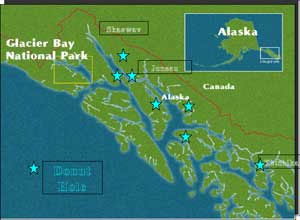
(courtesy: NOSB Team Gastineau)
Table 1. Overview of Wastewater Discharges from Cruise Ships Operating In Southeast
| Wastewater | Production/ 24 hour |
Holding Tank Capacity | Discharge Rate | Quality of Effluent |
|---|---|---|---|---|
| Blackwater (toilet water & medical facility water) | 20,441.2-0,945.1 Liters (5,400-6,100 gals) | 151,416.5- 99,674.4 Liters (40,000-132,000 gals) | 59,809.5-200,021.2 Liters (15,800-52,840 gals/hr) | Fecal Coliform count <200/100ml TSS <150 mg/1 BOD:TBD |
| Graywater (showers, sinks, food liquid) | 355,071.6-1,030,010.5 Liters (93,800-272,100 gals.) | 598,095.1-1,499,023.1 Liters (158,000-396,000 gals) | 59,809.5-200,021.2 Liters (15,800-52,840 gals) | Not yet determined |
| Oily Bilge Water | 4,921-20,062.7 Liters (1,300-5,300 gals) | 99,177.8-200,021.2 Liters (26,200-52,840 gals) | Oily water separator capable of treating up to 9,842.1 Liters (2,600 gals) of bilge water per hour | <15 ppm oil |
| Alaska Cruise Ship Initiative: Part I Final Report (Activities through June 1, 2000) | ||||
Table 2. Economic Significance of Tourism Industry, Juneau, AK
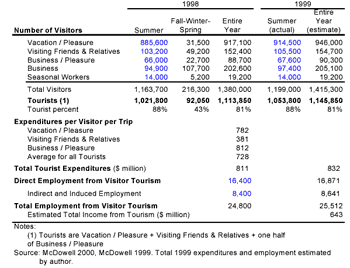
(Steve Colt, ISER)
Figure 2. Royal Caribbean Cruise Line's Save the Waves program resource flow (www.rccl.com).
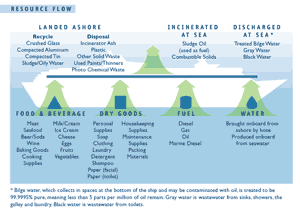
Figure 3. Site polluted by cruise ship industry (1991-2000).
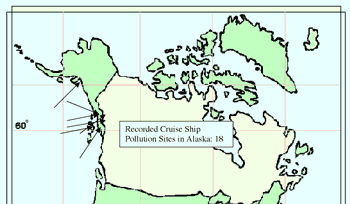
Courtesy: U. S. Coast Guard (some points may be layered)
Figure 4. Growth of summer arrivals (1989–1998) Juneau, Alaska
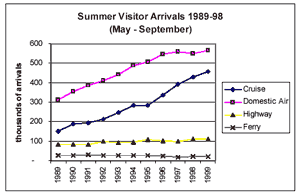
(Steve Colt, ISER)
This page is HTML
4.01 validated. Last modified
07-Apr-2003. Contact ASG web coordinator.